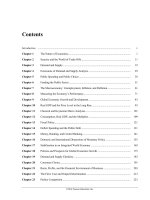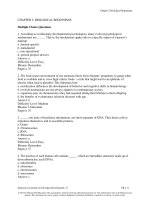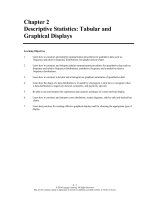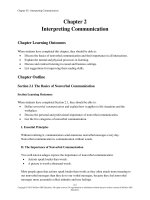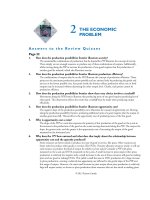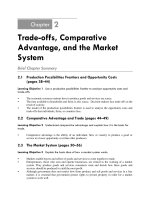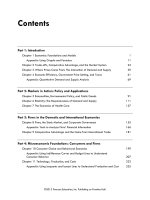Test bank and solution manual of economics by hubband (2)
Bạn đang xem bản rút gọn của tài liệu. Xem và tải ngay bản đầy đủ của tài liệu tại đây (1.74 MB, 45 trang )
Contents
Preface
vii
Part 1: Introduction
Chapter 1 Economics: Foundations and Models
1
Appendix: Using Graphs and Formulas
13
Chapter 2 Trade-offs, Comparative Advantage, and the Market System
23
Chapter 3 Where Prices Come From: The Interaction of Demand and Supply
43
Chapter 4 Economic Efficiency, Government Price Setting, and Taxes
69
Appendix: Quantitative Demand and Supply Analysis
78
Part 2: Markets in Action
Chapter 5 Externalities, Environmental Policy, and Public Goods
97
Chapter 6 Elasticity: The Responsiveness of Demand and Supply
119
Part 3: Firms in the Domestic and International Economies
Chapter 7 Firms, the Stock Market, and Corporate Governance
145
Appendix: Tools to Analyze Firms’ Financial Information
158
Chapter 8 Comparative Advantage and the Gains from International Trade
Appendix: Multinational Firms
171
184
Part 4: Microeconomic Foundations: Consumers and Firms
Chapter 9 Consumer Choice and Behavioral Economics
Appendix: Using Indifference Curves and Budget Lines to Understand
Consumer Behavior
Chapter 10 Technology, Production, and Costs
Appendix: Using Isoquants and Isocosts to Understand Production and Cost
©2010 Pearson Education, Inc. Publishing as Prentice Hall
195
206
221
235
iv
Contents
Part 5: Market Structure and Firm Strategy
Chapter 11 Firms in Perfectly Competitive Markets
253
Chapter 12 Monopolistic Competition: The Competitive Model in a More Realistic Setting 279
Chapter 13 Oligopoly: Firms in Less Competitive Markets
301
Chapter 14 Monopoly and Antitrust Policy
325
Chapter 15 Pricing Strategy
347
Part 6: Markets for Factors of Production
Chapter 16 The Markets for Labor and Other Factors of Production
361
Part 7: Information, Taxes, and the Distribution of Income
Chapter 17 The Economics of Information
393
Chapter 18 Public Choice, Taxes, and the Distribution of Income
407
Part 8: Macroeconomic Foundations and Long-Run Growth
Chapter 19 GDP: Measuring Total Production and Income
431
Chapter 20 Unemployment and Inflation
447
Chapter 21 Economic Growth, the Financial System, and Business Cycles
471
Chapter 22 Long-Run Economic Growth: Sources and Policies
487
Part 9: Short-Run Fluctuations
Chapter 23 Aggregate Expenditure and Output in the Short Run
Appendix: The Algebra of Macroeconomic Equilibrium
Chapter 24 Aggregate Demand and Aggregate Supply Analysis
Appendix: Macroeconomic Schools of Thought
©2010 Pearson Education, Inc. Publishing as Prentice Hall
507
519
531
543
Contents
v
Part 10: Monetary and Fiscal Policy
Chapter 25 Money, Banks, and the Federal Reserve System
553
Chapter 26 Monetary Policy
575
Chapter 27 Fiscal Policy
605
Appendix: A Closer Look at the Multiplier
Chapter 28 Inflation, Unemployment, and Federal Reserve Policy
622
635
Part 11: The International Economy
Chapter 29 Macroeconomics in an Open Economy
655
Chapter 30 The International Financial System
677
Appendix: The Gold Standard and the Bretton Woods System
©2010 Pearson Education, Inc. Publishing as Prentice Hall
685
Preface
Features of this Instructor’s Manual
Each chapter of this Instructor’s Manual contains the following elements:
Chapter Summary
An overview of the main economic concepts covered.
Learning Objectives
A list of the student learning goals listed at the beginning of each text chapter.
Chapter Outline with Teaching Tips
Detailed descriptions of the economic concepts in the book, key term definitions, and teaching tip boxes.
The teaching tip boxes include recommendations on how to integrate key figures and tables as well as
special features such as the An Inside Look newspaper feature, Economics in YOUR LIFE!, Making the
Connection, Solved Problems, and Don’t Let This Happen to YOU!
Extra Solved Problems
Each chapter of the main text has a Solved Problem to support two of the chapter’s learning objectives.
This Instructor’s Manual includes Solved Problems for the remaining learning objectives. You can assign
these extra Solved Problems as homework or present them during classroom lectures.
Extra Economics in YOUR LIFE!
Each chapter of the book opens and closes with a special feature entitled Economics in YOUR LIFE! that
emphasizes the connection between the material and the students’ personal experiences and questions.
This Instructor’s Manual includes an extra Economics in YOUR LIFE! for each chapter to present in
class.
Extra Making the Connection
Each chapter of the main text has two or more Making the Connection features to provide real-world
reinforcement of key concepts. This Instructor’s Manual includes extra Making the Connections to
present in class.
Solutions to Review Questions and Problems and Applications
Each chapter of this Instructor’s Manual includes solutions to all questions and problems in the main text:
• Solutions to the two Thinking Critically questions that accompany the An Inside Look
newspaper feature located at the end of each chapter
• Solutions to the end-of-chapter Review Questions
• Solutions to the end-of-chapter Problems and Applications
Revisions to the Main Text
If you used Hubbard/O’Brien, ECONOMICS, SECOND EDITION, here is a summary of the changes the
authors made to the main text. Knowing about these changes will help you revise your current teaching
notes and class presentations.
©2010 Pearson Education, Inc. Publishing as Prentice Hall
viii
Preface
The effects of the severe economic downturn that began in 2007 with the bursting of the housing bubble
continued through 2009. Unemployment rose to levels that had not been seen in decades, and the crisis in
the financial system was the worst since the Great Depression of the 1930s. Policy debates intensified
during 2009, as Congress passed and President Barack Obama enacted the Recovery and Reinvestment
Act, the largest package of spending increases and tax cuts in history. The Federal Reserve sailed into
uncharted waters as it developed new policy tools to deal with the unprecedented financial turmoil. Other
long-running policy debates continued as well, as reform of the health care system, the looming cost
increases of Social Security and Medicare, environmental policy, and changes to the tax system all
received attention from economists, policymakers, and the public. In the fourth edition, we help students
understand these recent economic events and the policy responses to them. As in the first and second
editions, we place applications at the forefront of the discussion because we believe that students find the
study of economics more interesting and easier to master when they see economic analysis applied to the
real-world issues that concern them.
In this new edition, we have taken the opportunity to make many changes throughout the text,
concentrating on the following key areas:
Policy debates, including immigration, health care, and pollution. The number of jobs requiring
technical education and training continues to increase. In Chapter 1, “Economics: Foundations and
Models,” we use the debate about restricting H-1B worker visas to introduce students to positive and
normative economic analysis. In Chapter 8, “Comparative Advantage and the Gains from International
Trade,” we explore the “Buy American” provision in the 2009 stimulus package. As this book goes to
press, Congress is debating a bill to overhaul the health care system. In Chapter 2, “Trade-offs,
Comparative Advantage, and the Market System,” we discuss the trade-offs involved in health care
spending and the Medicare and Medicaid programs. We revisit the topic of health care in Chapter 5,
“Externalities, Environmental Policy, and Public Goods,” where we discuss projections of health care
spending and the role of the U.S. government in the health care system. In Chapter 16, “The Markets for
Labor and Other Factors of Production,” we discuss whether U.S. firms are handicapped in competing
with foreign firms by paying for their employees’ health insurance. We return to the health care topic in
Chapter 18, “Public Choice, Taxes, and the Distribution of Income,” with a news article and analysis on a
proposed soda tax to pay for health care. The United States has made progress in reducing air pollution
since Congress passed the Clean Air Act in 1970. In Chapter 5, “Externalities, Environmental Policy, and
Public Goods,” we use the economic concepts of marginal cost, marginal benefit, and efficiency to
discuss environmental policy, including President Barack Obama’s proposed cap-and-trade policy to
reduce emissions of carbon dioxide.
The recession and financial crisis of 2007–2009. Today’s students feel the effects of the worst economic
crisis since the Great Depression of the 1930s. The problems in the financial system have proven that it is
important for students in both microeconomics and macroeconomics courses to understand the basics of
how financial markets work and the role of government in financial regulation. In Chapter 7, “Firms, the
Stock Market, and Corporate Governance,” we cover the basics of the stock and bond markets, discuss
why stock prices fluctuate, and examine the role of the principal-agent problem in the financial meltdown
of 2007–2009.We return to the financial crisis in Chapter 17, “The Economics of Information,” where we
use Bernie Madoff’s “Ponzi” scheme to illustrate moral hazard. Chapter 24, “Aggregate Demand and
Aggregate Supply Analysis,” covers the origins of the recession and includes a new discussion of how
long it takes the economy to return to potential GDP. The housing bust and subprime crisis are discussed
in Chapter 25,“Money, Banks, and the Federal Reserve System,” and Chapter 26,“Monetary Policy.”
New initiatives by the Federal Reserve. During 2008, the Fed dramatically broke with precedent by
setting up a number of new “lending facilities” and by participating in actions such as the purchase of
Bear Stearns by JP Morgan Chase. In this new edition, we provide students with a basic background on
investment banks, the process of securitization—including a new explanatory figure—and the mortgage-
©2010 Pearson Education, Inc. Publishing as Prentice Hall
Preface
ix
backed securities market—including the roles of Fannie Mae and Freddie Mac—and the debate among
economists concerning the Fed’s new policies. Chapter 25 contains an important new section on the rise
of the “shadow banking” system and a new supporting figure, Figure 25-4, to explain securitization.
Real-world company examples and newspaper articles. As in previous editions, we open each chapter by
highlighting a company to establish a real-world context for learning and to spark students’ interest in
economics. We have chosen new companies for some chapters and updated the information in the other
chapters. As in previous editions, each chapter closes with the An Inside Look feature, which shows
students how to apply the concepts from the chapter to the analysis of a news article. We have replaced all
the An Inside Look features in this edition. Here is a snapshot of some of these changes: Chapter 3,
“Where Prices Come From: The Interaction of Demand and Supply,” opens with a discussion of Red Bull
and the market for energy drinks. The An Inside Look feature presents an article and analysis of how
advertising helps Red Bull increase the demand for its energy drink. Chapter 7, “Firms, the Stock Market,
and Corporate Governance,” opens with a discussion of the runaway success of the private company
Facebook. The An Inside Look feature presents an article and analysis about Facebook and profits.
Chapter 9, “Consumer Choice and Behavioral Economics,” opens with a discussion of how Oprah
Winfrey’s endorsement of the Kindle e-reader caused a dramatic increase in demand for the product. The
An Inside Look feature presents an article and analysis on the power of Oprah Winfrey’s endorsements.
Chapter 19, “GDP: Measuring Total Production and Income,” opens with a discussion of Ford Motor
Company’s performance during the 2007–2009 recession. The An Inside Look feature presents an article
and analysis of the effects of falling auto sales on the U.S. economy. Chapter 26, “Monetary Policy,”
opens with a discussion of homebuilder Toll Brothers. The An Inside Look feature presents an article and
analysis of the effect of the trouble in the housing market on the U.S. and European economies.
Here is a list of additional changes to this third edition:
Chapter 1 includes a new Making the Connection, “Should the Federal Government Have
Increased Restrictions on the Immigration of Skilled Workers?”
Chapter 2 includes a new Making the Connection, “Facing the Trade-offs in Health Care
Spending.”
Chapter 3 includes three new Making the Connection features: “Is the Big Mac an Inferior
Good?” “The Aging of the Baby Boom Generation,” and “Red Bull and the Future Demand for
Energy Drinks.”
Chapter 4 includes a new Making the Connection, “The Consumer Surplus from Broadband
Internet Service.”
Chapter 5 includes revised graphs of the economic effects of government taxes and subsidies to
improve student understanding of this sometimes difficult subject, and a new Making the
Connection, “Should the Government Run the Health Care System?”
Chapter 6 includes a new section and table on “Some Estimated Price Elasticities of Demand.”
Chapter 7 includes a new section and figure on “Why Do Stock Prices Fluctuate So Much?” and a
new Making the Connection, “How Important Are Small Businesses to the U.S. Economy?”
Chapter 8 includes two new Making the Connection features, “How Caterpillar Depends on
International Trade” and “The Obama Administration Develops a Trade Policy.”
Chapter 9 includes two new Making the Connection features, “Are There Any Upward-Sloping
Demand Curves in the Real World?” and “A Blogger Who Understands the Importance of Sunk
Costs.”
©2010 Pearson Education, Inc. Publishing as Prentice Hall
Preface
x
Chapter 11 includes several cost and revenue graphs that have been redrawn for increased clarity,
as well as a new Making the Connection, “Easy Entry Makes the Long Run Pretty Short in the
Apple iPhone Apps Store.”
Chapter 12 includes a new Making the Connection, “The Rise and Decline of Starbucks.”
Chapter 13 includes a new Making the Connection, “Can We Predict Which Firms Will Continue
to Be Successful?”
Chapter 14 includes a new Making the Connection, “Have Google and Microsoft Violated
Antitrust Laws?”
Chapter 16 contains a new Making the Connection, “Are U.S. Firms Handicapped by Paying
Their Employees’ Health Insurance?”
Chapter 17 includes a new Making the Connection, “Moral Hazard, Big Time: Bernie Madoff’s
‘Ponzi’ Scheme.”
Chapter 19 includes a new Making the Connection on the decline in consumption spending and
increase in saving during the recession.
Chapter 20 includes a new Making the Connection on the surprising increase in male
unemployment relative to female unemployment during the recession.
Chapter 21 includes a new Making the Connection on firms that decide to expand even as their
sales fall during a recession.
Chapter 23 includes a new section on the “paradox of thrift.”
Chapter 27 includes a new Making the Connection on the debate over the size of the government
spending multiplier. In discussing the tax cuts in the stimulus program, we include a new section
on the different effects temporary and permanent tax changes have on consumption spending.
Chapter 30 includes a new Making the Connection on the debate over whether the euro helped or
hurt Europe in dealing with the recession.
•
Many instructors have found our dynamic aggregate demand and aggregate supply model to be an
important improvement on the usual static model. We understand, however, that some instructors
would prefer to concentrate on the basic model. So, in the third edition, our discussion of the
dynamic model appears in one entirely self-contained section in each of Chapters 24, 26, and 27.
These sections can be omitted with no loss of continuity because knowledge of the dynamic
model is not presumed in any of the discussion outside of these sections.
•
Figures and tables have been updated using the latest data available.
•
Approximately 30 percent of the end-of-chapter problems have been either replaced or updated.
Organizing Your Syllabus
The Instructor’s Manual can be a valuable resource for both experienced and first-time instructors. Both
the textbook and Instructor’s Manual provide comprehensive coverage of economic theory, monetary
policy, fiscal policy, and real-world applications.
©2010 Pearson Education, Inc. Publishing as Prentice Hall
Preface
xi
Microeconomic Chapters
The microeconomics chapters cover relatively new developments in the field, such as behavioral and
personnel economics (Chapter 16) and the economics of information (Chapter 17). The authors include
business applications in each chapter and have a dedicated chapter on firms, the stock market, and
corporate governance (Chapter 7). The comprehensive coverage of microeconomics and business topics
allows instructors to select chapters for diverse groups of students.
Most instructors will not want to cover indifference curve analysis or isoquant and isocost curves, but
those who wish to will find these topics covered in the appendices to Chapter 9, “Consumer Choice and
Behavioral Economics,” and Chapter 10, “Production, Technology, and Costs,” respectively. Chapter 13
of this instructor’s manual, “Oligopoly: Firms in Less Competitive Markets,” includes coverage of the
kinked demand curve that does not appear in the main book.
First-time users of the textbook should be aware that some topics introduced in one chapter are applied in
a later chapter. Chapter 4, “Economic Efficiency, Government Price Setting, and Taxes,” introduces
consumer, producer and economic surplus to describe the impact of government-imposed price controls.
The appendix to chapter 4, “Quantitative Demand and Supply Analysis,” explains in detail how consumer
and producer surplus are calculated using linear demand and supply curves. Chapter 8, “Comparative
Advantage and the Gains from International Trade,” uses the same tools to measure the impact of tariffs
and quotas on international trade.
Macroeconomic Chapters
Chapter 19, “GDP: Measuring Total Production and Income,” and Chapter 8, “Unemployment and
Inflation” carefully provide definitions of macroeconomic statistics such as GDP, CPI, and payroll
employment, that dominate news headlines.
The comprehensive coverage of macroeconomic models and policy issues allows instructors with
somewhat different course objectives the flexibility to choose different chapter sequences. The authors
provide an overview of issues of long-run growth, business cycles, and the financial system in Chapter
21, “Economic Growth, the Financial System, and Business Cycles.” Instructors who wish to explore
more deeply the sources of long-run growth and government policies towards growth can also assign
Chapter 22, “Long-Run Economic Growth: Sources and Policies.” Monetary policy has a central role in
the economy, so the book includes two chapters on monetary policy: Chapter 26, “Monetary Policy,” and
Chapter 28, “Inflation, Unemployment, and Federal Reserve Policy.” Chapter 28 discusses the role of the
Fed and inflation targeting with an insider’s perspective.
Chapter 23, “Aggregate Expenditure and Output in the Short Run,” contains a thorough discussion of the
traditional Keynesian 45o-line aggregate expenditure model. Many instructors find this model useful in
introducing students to the short-run relationship between spending and production. However, instructors
may also safely omit Chapter 23 and proceed directly to Chapter 24, “Aggregate Demand and Aggregate
Supply Analysis.”
Chapter 24 carefully develops the AD-AS model and then makes the model dynamic in an optional
section to account better for actual movements in real GDP and the price level. Chapter 24 includes a
three-layer, full-color acetate for the key introductory dynamic AD-AS graph (Figure 24-8, “A Dynamic
Aggregate Demand and Aggregate Supply Model” on page 806.) We created this acetate to help students
see how the graph builds step by step and to help make the graph easier for instructors to present. The
acetate will help instructors who want to use dynamic AD-AS in class but believe the model needs to be
developed carefully. Instructors may safely omit the sections on the dynamic AD-AS model in Chapter 26,
“Monetary” and in Chapter 27, “Fiscal Policy,” without any loss in continuity to the discussion of
macroeconomic theory and policy.
©2010 Pearson Education, Inc. Publishing as Prentice Hall
xii
Preface
The following chart helps you organize your syllabus based on your teaching preferences and objectives:
CORE
POLICY
OPTIONAL
Chapter 1: Economics: Foundations
and Models
Uses the immigration debate to
discuss the role of models in
economic analysis.
Chapter 2: Trade-offs, Comparative
Advantage, and the Market
System
Includes coverage of the role of
the entrepreneur, property rights,
and the legal system in a successful
market system.
Chapter 3: Where Prices Come
From: The Interaction of Demand
and Supply
Chapter 6: Elasticity: The
Responsiveness of Demand and
Supply
Chapter 8: Comparative Advantage
and the Gains from International
Trade
May be delayed until after
Chapter 16.
Chapter 10: Technology, Production,
and Costs
Chapter 11: Firms in Perfectly
Competitive Markets
Chapter 12: Monopolistic
Competition: The Competitive
Model in a More Realistic Setting
Chapter 13: Oligopoly: Firms in Less
Competitive Markets
Full coverage of game theory and
unique coverage of Porter’s Five
Forces Model of Competition.
Chapter 14: Monopoly and Antitrust
Policy
May be covered after chapter 11.
Chapter 16: The Markets for Labor
and Other Factors of Production
Covers all factors of production in
one chapter and includes coverage
of discrimination, unions,
compensating differentials, and
personnel economics.
Chapter 4: Economic Efficiency,
Government Price Setting, and
Taxes
Chapter 5: Externalities,
Environmental Policy, and Public
Goods
This chapter may be delayed until
after Chapter 14.
Chapter 18: Public Choice, Taxes,
and the Distribution of Income
Chapter 26: Monetary Policy
Uses the aggregate demand and
aggregate supply model to show
the effects of monetary policy on
real GDP and the price level.
Chapter 26 is a self-contained
discussion, so instructors may
safely omit the material in
Chapter 28.
Chapter 27: Fiscal Policy
Uses the aggregate demand and
aggregate supply model to show
how taxes and government
spending affect the economy.
Includes significant coverage of
the supply-side effects of fiscal
policy.
Chapter 1 Appendix: Using Graphs
and Formulas
Chapter 4 Appendix: Quantitative
Demand and Supply Analysis
Provides a quantitative analysis of
rent control.
Chapter 7: Firms, the Stock Market,
and Corporate Governance
Unique chapter.
Chapter 7 Appendix: Tools to
Analyze Firms’ Financial
Information
Covers present value and financial
statements.
Chapter 8 Appendix: Multinational
Firms
Covers the benefits and challenges
of operating overseas businesses.
Chapter 9: Consumer Behavior and
Behavioral Economics
Covers utility theory and unique
coverage of social influences on
behavior and network externalities.
Chapter 9 Appendix: Using
Indifference Curves and Budget
Lines to Understand Consumer
Behavior
Complete and intuitive coverage
for those instructors who prefer to
cover indifference curves rather
than utility theory.
Chapter 10 Appendix: Using
Isoquants and Isocosts to
Understand Production and Cost
Provides a formal analysis of how
firms choose the combination of
inputs to produce a given level of
output.
Chapter 15: Pricing Strategy
Unique chapter that covers price
discrimination, cost-plus pricing,
and two-part tariffs.
©2010 Pearson Education, Inc. Publishing as Prentice Hall
Preface
CORE
POLICY
Chapter 17: The Economics of
Information
Covers asymmetric information and
moral hazard.
Chapter 19: GDP: Measuring
Total Production and Income
Covers how total production is
measured and the difference
between real and nominal
variables.
Chapter 20: Unemployment and
Inflation
Covers the three types of
unemployment, how inflation is
measured, and the difference
between real and nominal interest
rates.
Chapter 21: Economic Growth, the
Financial System, and Business
Cycles
Provides an overview of key
macroeconomic issues by discussing
the business cycle in the context of
long-run growth. Discusses the roles
of entrepreneurship, financial
institutions, and policy in economic
growth.
Chapter 22: Long-Run Economic
Growth: Sources and Policies
Highlights the importance of
institutions, policies, and
technological change for economic
growth.
Chapter 24: Aggregate Demand
and Aggregate Supply Analysis
This chapter carefully develops the
AD-AS model and then makes the
model dynamic to better account
for actual movements in real GDP
and the price level. The dynamic
AD-AS model is covered in an
optional section, which instructors
can omit without loss of continuity.
Chapter 25: Money, Banks, and the
Federal Reserve System
Explores the role of money in the
economy, the money supply
process, and the structure of the
Federal Reserve.
xiii
OPTIONAL
Chapter 23: Output and
Expenditure in the Short Run
Uses the Keynesian 45°-line
aggregate expenditure model to
introduce students to the short-run
relationship between spending and
production. The discussion of
monetary and fiscal policy in later
Chapters uses only the aggregate
demand and aggregate supply
model, which allows instructors to
omit Chapter 23.
Chapter 23 Appendix: The Algebra
of Macroeconomic Equilibrium
Uses equations to represent the
aggregate expenditure model
described in the Chapter.
Chapter 24 Appendix:
Macroeconomic Schools of
Thought
Covers the monetarist model, the
new classical model, and the real
business cycle model.
Chapter 28: Inflation,
Unemployment, and Federal
Reserve Policy
Discusses the short-run and longrun Phillips curves. Also covers the
roles of expectations formation
and central bank credibility in
monetary policy.
Chapter 29: Macroeconomics in an
Open Economy
Explains the linkages among
countries at the macroeconomic
level and how policymakers in all
countries take these linkages into
account when conducting monetary
and fiscal policy.
Chapter 30: The International
Financial System
Covers the international financial
system and explores the role
central banks play in the system.
©2010 Pearson Education, Inc. Publishing as Prentice Hall
xiv
Preface
MyEconLab for Instructors & Students
MyEconLab is a unique online course management, testing, and tutorial resource.
MyEconLab For the Professor
Instructors can choose how much or how little time to spend setting up and using MyEconLab. Each
chapter contains two preloaded homework exercise sets that can be used to build an individualized study
plan for each student. These study plan exercises contain tutorial resources, including instant feedback,
links to the appropriate learning objective in the eText, pop-up definitions from the text, learning
objective summaries, and step-by-step guided solutions, where appropriate. Student use of these materials
requires no initial instructor setup. The online gradebook records each student’s performance and time
spent on the tests and study plan and generates reports by student or by chapter.
Alternatively, instructors can fully customize MyEconLab to match their course exactly, including
reading assignments, homework assignments, video assignments, current news assignments, and quizzes
and tests. Assignable resources include:
• Preloaded homework exercise sets for each chapter that include the student tutorial
resources mentioned above
• Preloaded quizzes for each chapter that are unique to the text and not repeated in the
study plan or homework exercise sets
• Study plan problems that are similar to the end-of-chapter problems and numbered
exactly like the book to make assigning homework easier
• Economics in the News articles that are updated weekly with appropriate exercises
• ABC News clips, which explore current economic applications and policy issues, along
with exercises
• Test Item File questions that allow you to assign quizzes or homework that will look just
like your exams
• Econ Exercise Builder, which allows you to build your own customized exercises
©2010 Pearson Education, Inc. Publishing as Prentice Hall
Preface
xv
Exercises include multiple-choice, graph drawing, and free-response items, many of which are generated
algorithmically so that each time a student works them, a different variation is presented. MyEconLab
grades every problem, even problems with graphs. When working homework exercises, students receive
immediate feedback, with links to additional learning tools.
Customization and Communication
MyEconLab in CourseCompass provides additional optional customization and communication tools.
Instructors who teach distance-learning courses or very large lecture sections find the CourseCompass
format useful because they can upload course documents and assignments, customize the order of
chapters, and use communication features such as Digital Dropbox and Discussion Board.
MyEconLab: Moving to a New Edition
When a new edition of your textbook publishes, you do not have to re-create all your assignments. You
can import assignments from a previous edition of the same book.
Not every exercise from the previous edition is included in the new edition. Once your assignments have
been imported, a list of any exercises that did not convert will be displayed as well as emailed to you.
Please use this list to help you find suitable replacement exercises in the new edition. You must first allow
assignments from old edition to be imported.
©2010 Pearson Education, Inc. Publishing as Prentice Hall
xvi
Preface
In the old edition course:
1. Click on Homework Manager
2. Click Show All to see all assignments (HW, Quizzes, Tests)
3. Choose Change Assignment Settings from Drop down menu
4. Check box for Allow Import
5. Click Update
©2010 Pearson Education, Inc. Publishing as Prentice Hall
Preface
xvii
Import Assignments into New Edition Course
1. Create course based on new edition of the book.
2. Click on Homework Manager
3. Under Create Assignment, choose Import/Copy Assignments from another course
4. Choose Convert and import assignments from courses using a previous edition of this book
or related books with similar coverage.
5. Click Next
©2010 Pearson Education, Inc. Publishing as Prentice Hall
xviii Preface
6. Choose if you wish to convert from one your courses or one from another instructor at your
institution.
7. Click Next
8. Choose the book and course to import from.
9. Click Next
©2010 Pearson Education, Inc. Publishing as Prentice Hall
Preface
xix
10. Select all the assignments you wish to import.
11. Click Import
You will then see a summary screen detailing which exercises were not converted so you can find
replacements. This same information will be sent to your MyEconLab registered email address.
©2010 Pearson Education, Inc. Publishing as Prentice Hall
xx
Preface
MyEconLab for the Student
MyEconLab puts students in control of their learning through a collection of testing, practice, and study
tools tied to the online, interactive version of the textbook and other media resources.
Students can study on their own, or they can complete assignments created by their instructor. Within
MyEconLab’s structured environment, students practice what they learn, test their understanding, and
pursue a personalized study plan generated from their performance on sample tests and from quizzes
created by their instructors. In Homework or Study Plan mode, students have access to a wealth of tutorial
features, including:
• Instant feedback on exercises that helps students understand and apply the concepts
• Links to the eText to promote reading of the text just when the student needs to revisit a
concept or explanation
• Step-by-step guided solutions that force students to break down a problem in much the
same way an instructor would do during office hours
• Pop-up summaries of the appropriate learning objective to remind students of key ideas
while studying
• Pop-up key term definitions from the eText to help students master the vocabulary of
economics
• Links to the important features of the eText, such as Solved Problems, Making the
Connection, An Inside Look, and Don’t Let This Happen to You!
©2010 Pearson Education, Inc. Publishing as Prentice Hall
Preface
•
xxi
A graphing tool that is integrated into the various exercises to enable students to build
and manipulate graphs so that students better understand how concepts, numbers, and
graphs connect
Additional MyEconLab Tools
MyEconLab includes the following additional features:
• eText—In addition to the portions of eText available as pop-ups or links, a fully
searchable eText is available for students who wish to read and study in a fully electronic
environment.
• Print upgrade—For students who wish to complete assignments in MyEconLab but read
in print, Pearson offers registered MyEconLab users a loose-leaf version of the print text
at a significant discount.
• Glossary flashcards—Every key term is available as a flashcard, allowing students to
quiz themselves on vocabulary from one or more chapters at a time.
• Research Navigator (CourseCompass version only)—Research Navigator provides
extensive help on the research process and four exclusive databases of credible and
reliable source material, including The New York Times, the Financial Times, and peerreviewed journals.
©2010 Pearson Education, Inc. Publishing as Prentice Hall
xxii
Preface
Other Supplements for Instructors
•
•
•
•
•
•
•
Two Test Item Files
TestGen Computerized Test Program
PowerPoint Lecture Presentation
Instructor’s Resource CD-ROM with Test Item Files, Instructor’s Manual, and
PowerPoint presentations
Classroom Response Systems
BlackBoard and WebCT Course Content
CourseSmart eTextbook
Two Test Item Files (in print format and electronic TestGen format)
Two Test Item Files accompany the text. Each Test Item File includes more than 2,000 multiple-choice,
short answer, and graphing questions.
Test questions are annotated with the following information:
Difficulty: 1 for straight recall, 2 for some analysis, 3 for complex analysis
Type: multiple-choice, true/false, short-answer, essay
Topic: the term or concept the question supports
Learning objective
Graphing
AACSB (see description that follows)
Page number
Special feature in the main book: chapter-opening business example, Economics in YOUR Life!,
Solved Problem, Making the Connection, Don’t Let this Happen to You! and An Inside Look.
The Association to Advance Collegiate Schools of Business (AACSB)
The test bank authors have connected select test bank questions to the general knowledge and skill
guidelines found in the AACSB standards.
What is the AACSB?
AACSB is a not-for-profit corporation of educational institutions, corporations, and other organizations
devoted to the promotion and improvement of higher education in business administration and
accounting. A collegiate institution offering degrees in business administration or accounting may
volunteer for AACSB accreditation review. The AACSB makes initial accreditation decisions and
conducts periodic reviews to promote continuous quality improvement in management education. Pearson
Education is a proud member of the AACSB and is pleased to provide advice to help you apply AACSB
Learning Standards.
What are AACSB Learning Standards?
One of the criteria for AACSB accreditation is the quality of the curricula. Although no specific courses
are required, the AACSB expects a curriculum to include learning experiences in such areas as:
• Communication
• Ethical Reasoning
• Analytic Skills
• Use of Information Technology
• Multicultural and Diversity
• Reflective Thinking
©2010 Pearson Education, Inc. Publishing as Prentice Hall
Preface xxiii
These six categories are AACSB Learning Standards. Questions that test skills relevant to these standards
are tagged with the appropriate standard. For example, a question testing the moral questions associated
with externalities would receive the Ethical Reasoning tag.
How Can Instructors Use the AACSB Tags?
Tagged questions help you measure whether students are grasping the course content that aligns with the
AACSB guidelines noted above. In addition, the tagged questions may help instructors identify potential
applications of these skills. This in turn may suggest enrichment activities or other educational
experiences to help students achieve these skills.
TestGen
The computerized TestGen package allows instructors to customize, save, and generate classroom tests.
The test program permits instructors to edit, add, or delete questions from the test banks; edit existing
graphics and create new graphics; analyze test results; and organize a database of tests and student results.
This software allows for extensive flexibility and ease of use. It provides many options for organizing and
displaying tests, along with search and sort features. The software and the test banks can be downloaded
from the Instructor’s Resource Center (www.pearsonhighered.com/hubbard).
PowerPoint® Slides (3 sets)
Three sets of PowerPoint® slides, prepared by Fernando Quijano and Yvonn Quijano, are available:
1. A comprehensive set of PowerPoint® slides can be used by instructors for class presentations or by
students for lecture preview or review. These slides include all the graphs, tables, and equations in
the textbook. Two versions are available—step-by-step mode, in which you can build graphs as you
would on a blackboard, and automated mode, in which you use a single click per slide.
2. A comprehensive set of PowerPoint® slides have Classroom Response Systems (CRS) questions
built in so that instructors can incorporate CRS “clickers” into their classroom lectures. For more
information on Pearson Education’s partnership with CRS, see the description below. Instructors
can download these PowerPoint presentations from the Instructor’s Resource Center
(www.pearsonhighered.com/hubbard).
3. A student version of the PowerPoint® slides is available as .pdf files. This version allows students to
print the slides and bring them to class for note taking. Instructors can download these PowerPoint®
presentations from the Instructor’s Resource Center (www.pearsonhighered.com/hubbard).
Instructor’s Resource CD-ROM
The Instructor’s Resource CD-ROM contains all the faculty and student resources that support this text.
Instructors have the ability to access and edit the
• Instructor’s Manual,
• Test Item Files, and
• PowerPoint presentations.
By simply clicking on a chapter or searching for a keyword, faculty can access an interactive library of
resources. Faculty can pick and choose from the various supplements and export them to their hard drives.
Blackboard and WebCT Course Content
Prentice Hall offers fully customizable course content for the Blackboard and WebCT Course
Management Systems.
Classroom Response Systems
Classroom Response Systems (CRS) is an exciting new wireless polling technology that makes large and
small classrooms even more interactive because it enables instructors to pose questions to their students,
record results, and display the results instantly. Students can answer questions easily, using compact
©2010 Pearson Education, Inc. Publishing as Prentice Hall
xxiv Preface
remote-control transmitters. Prentice Hall has partnerships with leading classroom response systems
providers and can show you everything you need to know about setting up and using a CRS system. We’ll
provide the classroom hardware, text-specific PowerPoint slides, software, and support, and we’ll also
show you how your students can benefit! Learn more at www.pearsonhighered.com/crs.
eTextbook
CourseSmart goes beyond traditional expectations providing instant, online access to the textbooks and
course materials you need at a lower cost to students. And, even as students save money, you can save
time and hassle with a digital textbook that allows you to search the most relevant content at the very
moment you need it. Whether it’s evaluating textbooks or creating lecture notes to help students with
difficult concepts, CourseSmart can make life a little easier. See how when you visit www.coursesmart.
com/instructors.
Other Supplements for Students
Study Guide
The study guide contains the following features:
• Chapter summary
• Discussion of each learning objective
• Section-by-section review of the concepts presented
• Helpful study hints
• Additional Solved Problems to supplement those in the text
• Key terms with definitions
• A self-test, including 40 multiple-choice questions, plus a number of short-answer
and true/false questions, with accompanying answers and explanations
PowerPoint Slides
For student use as a study aide or note-taking guide, PowerPoint slides, may be downloaded from the
companion Web site, at www.pearsonhighered.com/hubbard. The slides include:
• All graphs, tables, and equations in the text
• Figures in step-by-step, automated mode, using a single click per graph curve
• End-of-chapter key terms with hyperlinks to relevant slides
eTextbook
CourseSmart goes beyond traditional expectations providing instant, online access to the textbooks and
course materials students need at lower cost. They can also search, highlight, and take notes anywhere at
anytime. See all the benefits to students at www.coursesmart.com/students.
©2010 Pearson Education, Inc. Publishing as Prentice Hall
CHAPTER
1| Economics:
Foundations and Models
Brief Chapter Summary and Learning Objectives
1.1
Three Key Economic Ideas (pages 4–7)
Explain these three key economic ideas: People are rational. People respond to incentives.
Optimal decisions are made at the margin.
1.2
The Economic Problem That Every Society Must Solve (pages 7–11)
Discuss how an economy answers these questions: What goods and services will be
produced? How will the goods and services be produced? Who will receive the goods and
services produced?
1.3
1.5
A limited amount of resources can produce a limited amount of goods and services.
The cost of producing more of one good is the value of what must be given up to produce
it.
Economic Models (pages 11–14)
Understand the role of models in economic analysis.
1.4
People must make choices as they try to attain their goals. People make choices because
resources are scarce. Most of economics analyzes what happens in markets.
Economists use models—simplified versions of reality—to analyze real-world issues.
Economists accept a model if it leads to hypotheses that are confirmed by statistical
analysis.
Microeconomics and Macroeconomics (pages 14–15)
Distinguish between microeconomics and macroeconomics.
A Preview of Important Economic Terms (pages 15–16)
Become familiar with important economic terms.
Appendix: Using Graphs and Formulas (pages 24–35)
Review the use of graphs and formulas.
©2010 Pearson Education, Inc. Publishing as Prentice Hall
2
CHAPTER 1 | Economics: Foundations and Models
Key Terms
Allocative efficiency, p. 10. A state of the
economy in which production is in accordance
with consumer preferences; in particular, every
good or service is produced up to the point
where the last unit provides a marginal benefit to
society equal to the marginal cost of producing
it.
Centrally planned economy, p. 9. An
economy in which the government decides how
economic resources will be allocated.
Economic model, p. 4. A simplified version of
reality used to analyze real-world economic
situations.
Economic variable, p. 11. Something
measurable that can have different values, such
as the wages of software programmers.
Economics, p. 4. The study of the choices
people make to attain their goals, given their
scarce resources.
Equity, p. 10. The fair distribution of economic
benefits.
Macroeconomics, p. 14. The study of the
economy as a whole, including topics such as
inflation, unemployment, and economic growth.
Marginal analysis, p. 7. Analysis that involves
comparing marginal benefits and marginal costs.
Market, p. 4. A group of buyers and sellers of a
good or service and the institution or
arrangement by which they come together to
trade.
Market economy, p. 9. An economy in which
the decisions of households and firms interacting
in markets allocate resources.
Microeconomics, p. 14. The study of how
households and firms make choices, how they
interact in markets, and how the government
attempts to influence their choices.
Mixed economy, p. 10. An economy in which
most economic decisions result from the
interaction of buyers and sellers in markets but
in which the government plays a significant role
in the allocation of resources.
Normative analysis, p. 12. Analysis concerned
with what ought to be.
Opportunity cost, p. 8. The highest-valued
alternative that must be given up to engage in an
activity.
Positive analysis, p. 12. Analysis concerned
with what is.
Productive efficiency, p. 10. A situation in
which a good or service is produced at the
lowest possible cost.
Scarcity, p. 4. A situation in which unlimited
wants exceed the limited resources available to
fulfill those wants.
Trade-off, p. 8. The idea that because of
scarcity, producing more of one good or service
means producing less of another good or service.
Voluntary exchange, p. 10. A situation that
occurs in markets when both the buyer and seller
of a product are made better off by the
transaction.
©2010 Pearson Education, Inc. Publishing as Prentice Hall
CHAPTER 1 | Economics: Foundations and Models
3
Chapter Outline
Microsoft Versus the U.S. Congress on Worker Visas
U.S. law restricts the number of foreign “specialty workers” who may enter the United States under the
H-1B visa program to 65,000 per year. Despite arguments from business executives such as Bill Gates,
who claim that the visa program has resulted in a “critical shortage of scientific talent,” in 2009 Congress
tightened restrictions on the immigration of technical workers to the United States. Economists and
policymakers have debated whether restrictions on the immigration of technical workers are good or bad
for the U.S. economy.
>>Teaching Tips
There are special features that open and close each chapter of the book. The introduction, or chapter
opener, uses a real-world business example to preview the economic issues discussed in the chapter. The
end of the chapter includes a feature titled An Inside Look that consists of an article from a magazine or
newspaper plus analysis and questions. The article links back to the topic of the chapter opener. An
Inside Look in this chapter uses an article from the Economist to analyze immigration policy.
A feature titled Economics in YOUR LIFE! complements the business example that opens the
chapter. Economics in YOUR LIFE! poses questions that help students make a personal connection with
the chapter theme. At the end of the chapter, the authors use the concepts described in the chapter to
answer these questions. In this chapter students are asked if they will be competing with immigrant
workers when they apply for their next job. You can use these features—the chapter opener, Economics
in YOUR LIFE!, and An Inside Look—as the basis for classroom discussion, homework assignments,
and examination questions. This Instructor’s Manual includes one extra Economics in YOUR LIFE! for
each chapter so that you can present material in class that is different from the material found in the
textbook. Visit www.myeconlab.com for current An Inside Look news articles.
People must make choices as they try to attain their goals. The choices people make represent the tradeoffs made necessary by scarcity. Scarcity is a situation in which unlimited wants exceed the limited
resources available to fulfill those wants. Economics is the study of the choices people make to attain
their goals, given their scarce resources. An economic model is a simplified version of reality used to
analyze real-world economic situations.
>>Teaching Tips
It is important to define economics and explain what scarcity means at the beginning of the course,
especially because many students will not have studied economics previously. Some students will better
understand what scarcity means if you give them examples of things that are not scarce. You can provide
examples of “free resources”—sand on a beach, fresh air—and ask students to contribute their own
examples. Your students will quickly learn that the list of free resources is very much shorter than the list
of scarce resources.
1.1
Three Key Economic Ideas (pages 4–7)
Learning Objective: Explain these three key economic ideas: People are rational. People
respond to incentives. Optimal decisions are made at the margin.
A market is a group of buyers and sellers of a good or service and the institution or arrangement by
which they come together to trade. There are three important ideas students should learn to understand
©2010 Pearson Education, Inc. Publishing as Prentice Hall

